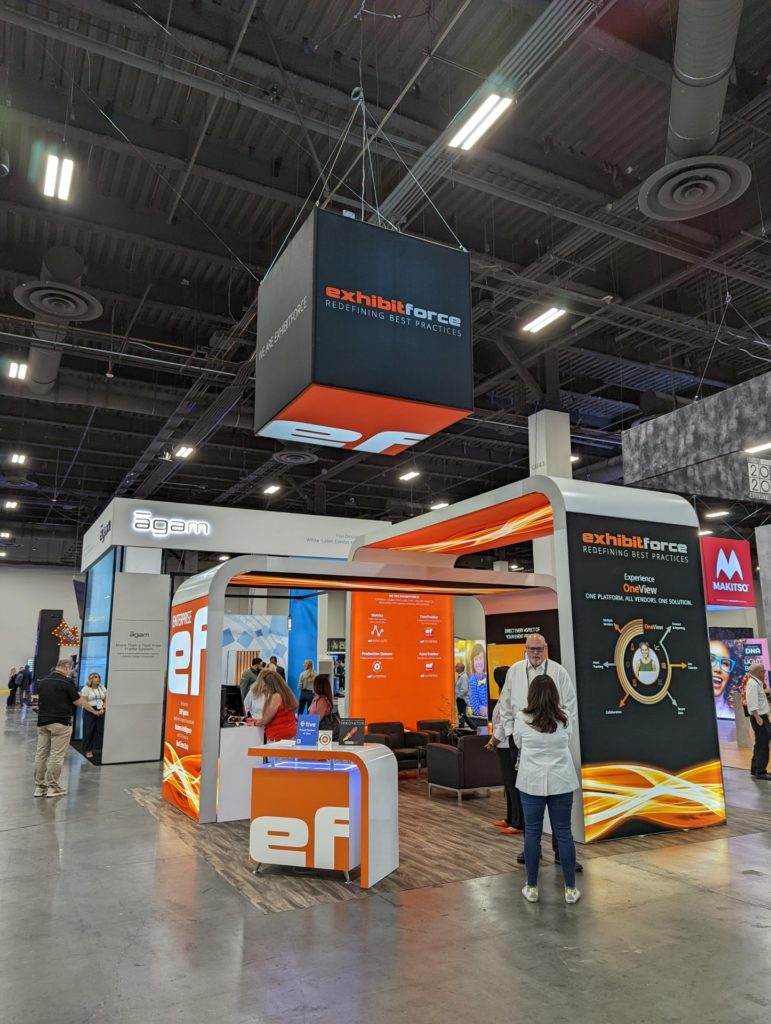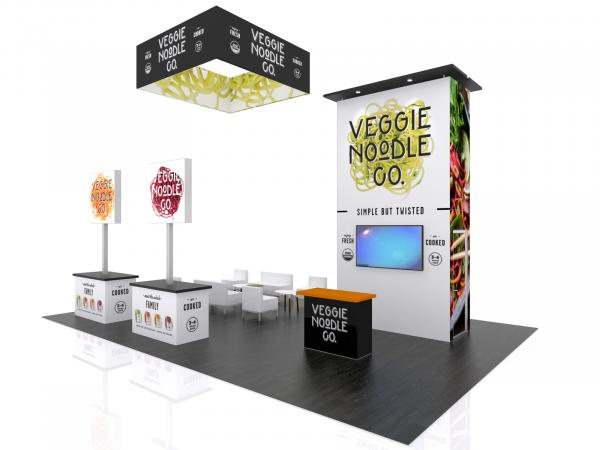Trade show marketing is a powerful way businesses can show off their products and services, meet new customers, and connect with other businesses. Imagine a large hall filled with booths, each representing a company. These booths are like mini-stores, where you can see new products in action, ask questions, and even get some free goodies. Attending these events gives businesses a unique chance to see what their competitors are up to and discover the latest trends in their industry.
For many companies, trade shows are a game-changer. It’s not just about having a flashy booth. It’s about making genuine connections with potential clients and partners, understanding what people in the market want, and getting direct feedback. If done right, the impact of participating in a trade show can be huge, boosting a company’s sales, reputation, and network in the business community.
Understanding the Essentials: What is Trade Show Marketing?
Before diving deep into the world of business and marketing, let’s first understand a common term you might have heard of: trade show marketing. It might sound complex, but it’s actually quite straightforward once broken down.
Simple Definition of a Trade Show
A trade show is like a big event or fair where different companies set up booths or stands to display and promote their products or services. Imagine walking through a large hall, and each booth you see represents a mini-store or business. It’s a place filled with action, where brands can show the world what they’ve got.
Explanation of the Primary Purpose of Trade Shows
So, why do businesses set up these booths and spend time at trade shows? There are a few main reasons:
Showcasing Products: This is a chance for companies to display their latest products or services. It’s like a stage where they can show off what’s new and exciting in their lineup. Visitors can see, touch, and sometimes even try these products.
Meeting Potential Customers: It’s not just about showing products. It’s also about meeting the people who might buy them. At trade shows, businesses can directly interact with potential clients or customers, answer their questions, and even make sales on the spot.
Networking with Other Businesses: Trade shows aren’t just about customers. They’re also a great place for businesses to meet other businesses. Maybe they can find a new supplier, partner, or even a collaborator for a future project. It’s a bustling hub of opportunities.
Trade show marketing, therefore, is all about making the most of these events. It’s about designing the perfect booth, training staff to answer questions, and preparing to make those all-important business connections.
Key Components of Trade Show Marketing
When it comes to trade show marketing, success isn’t just about showing up. It’s about standing out, creating memorable impressions, and fostering connections. There are several key components to achieving success in trade show marketing. Let’s delve deeper into each one:
Booth Design and Presentation
Your booth is the face of your company during the trade show. It’s the first thing attendees will see, and it plays a massive role in attracting them towards your brand.
- Importance of an Appealing and Effective Booth Design: A well-designed booth speaks volumes about your brand. It’s not just about aesthetics; it’s about reflecting your company’s ethos, culture, and offerings. An appealing booth is like a magnet – it draws people in, piquing their curiosity and encouraging them to learn more about what you offer.
- How It Helps in Attracting Potential Clients or Partners: First impressions count. When attendees see a booth that’s vibrant, well-organized, and engaging, they’re more likely to associate those positive attributes with the brand itself. A great trade show booth design can spark conversations, leading to potential business opportunities and collaborations.
Find out the most popular booths: 10×10 turnkey trade show kit and 10×20 turnkey trade show kit.
Product Demonstrations
Trade shows provide a golden opportunity to showcase what your company does best: its products or services.
- Showcasing Products or Services to Attendees: This is your chance to highlight your latest innovations, bestsellers, or unique offerings. Demonstrating your products in action can captivate attendees, showing them the tangible benefits they can expect.
- Offering Hands-on Experiences to Engage Potential Clients: Letting attendees touch, feel, or experience your product can create a lasting impression. It goes beyond mere observation – it’s about creating a connection, an experience that attendees will associate with your brand.

Promotional Material
In the bustling environment of a trade show, you need more than just words to make an impression.
- Brochures, Flyers, and Giveaways: These tangible items can act as reminders of your brand long after the trade show ends. Well-designed brochures or flyers can provide detailed information about your products or services, while giveaways (like branded pens or bags) can serve as a constant brand reminder.
- The Role They Play in Marketing and Brand Recognition: These materials not only inform but also reinforce brand identity. When attendees take home a piece of your brand, it extends the conversation beyond the trade show, potentially leading to future interactions and business opportunities.
Find out the most popular tradeshow booth accessories.
Networking Opportunities
Trade shows are more than just a space for business transactions; they’re a hub for meaningful connections.
- Engaging with Other Exhibitors and Attendees: Interaction shouldn’t be limited to potential customers. Other exhibitors can provide insights, partnerships, or even collaborative opportunities that can benefit your business.
- Building Business Relationships and Collaborations: The connections made during trade shows can lead to lasting business relationships. Whether it’s finding a new supplier, distributor, or even a future business partner, trade shows offer a conducive environment to expand your business network and horizons.
What is Trade Show Marketing and Its Multifaceted Benefits
Trade shows are more than just events where businesses set up booths and display products. They offer a multitude of benefits that can significantly impact a company’s growth, brand, and customer relationships. Here are some of the standout benefits of trade show marketing:
Direct Customer Engagement
One of the primary advantages of participating in trade shows is the opportunity for direct engagement with customers and potential clients.
- Face-to-face Interaction with Potential Clients or Customers: In today’s digital age, face-to-face interactions have become rare yet invaluable. Trade shows offer businesses a unique chance to meet potential clients in person, build trust, and create lasting impressions.
- Immediate Feedback and Addressing Concerns Directly: Interacting with attendees allows businesses to receive instant feedback on their products, services, or brand presentation. This real-time insight is precious, enabling companies to address concerns on the spot and make immediate improvements.

Brand Exposure
Trade shows gather a vast audience, making them a perfect platform for brands to amplify their presence.
- Raising Brand Awareness Among a Large Audience: With hundreds or even thousands of attendees, trade shows can introduce a brand to a wide array of potential customers, partners, and other stakeholders in one location.
- Differentiating Yourself from Competitors: Amidst a sea of competitors, a well-prepared trade show presence allows a brand to highlight its unique selling propositions, distinguishing itself and standing out in the crowd.
Read my guide to trade show hanging signs.
Lead Generation
Trade shows can be goldmines for collecting valuable leads that can be nurtured into future business opportunities.
Collecting Contact Details of Interested Attendees for Future Marketing Efforts: Attendees who express interest in a brand’s offerings often leave their contact details. This data becomes a valuable resource for post-event marketing campaigns and outreach efforts.
Market Research
Beyond sales and branding, trade shows offer a unique perspective into the broader market landscape.
Learning About Industry Trends and Competitor Products or Strategies: By observing other booths, interacting with industry peers, and attending seminars or workshops, businesses can gain insights into emerging trends, innovative products, and competitors’ strategies. This knowledge can be instrumental in refining a company’s own strategies and staying ahead in the market.

What is Trade Show Marketing? Understanding Its Challenges and Pitfalls to Avoid
Trade shows can bring a lot of benefits, like meeting new customers and promoting your brand. But, there are also challenges that companies face when they decide to join a trade show. Let’s explore these challenges and understand how to avoid common mistakes:
High Costs Associated with Exhibiting at Trade Shows
Setting up at a trade show isn’t cheap. There are costs for booking space, designing the booth, travel, accommodation, and promotional materials. Plus, don’t forget the fees for registering at the event.
If you don’t budget carefully, you might end up spending more than you planned. It’s essential to remember that the most expensive option isn’t always the best. Look for ways to save money without compromising on quality.
Read my guide about are trade shows worth it.
Importance of Clear Objectives and Planning Ahead
Imagine going on a trip without a map or plan. You might end up lost! The same goes for trade shows.
Before joining a trade show, ask yourself: “What do we want to achieve?” Maybe you want to promote a new product, or perhaps you’re looking to meet potential partners. Having clear goals will guide your actions and help you measure your success after the event. Also, planning in advance can prevent last-minute stress and help ensure everything runs smoothly.
The Challenge of Standing Out in a Crowded Market
At a trade show, there are many booths, and each one is trying to grab attention. How do you make sure people notice yours?
It’s not just about having the flashiest booth or the loudest music. Think about what makes your brand unique. Maybe it’s your story, or perhaps it’s a special product feature. Focus on that uniqueness, and find creative ways to showcase it. Remember, it’s about making a genuine connection with attendees.
Read my guide how to have a successful trade show booth.
Potential for Wasted Resources if Not Properly Prepared
Trade shows require time, effort, and money. But, if you’re not prepared, all these resources can go to waste.
Preparation is more than just setting up a booth. It’s about training your staff, understanding the attendees, and having a clear strategy. For example, if your team doesn’t know how to engage visitors or answer questions, potential customers might walk away. Or, if you bring a lot of promotional materials but don’t distribute them effectively, they might end up unused. Being well-prepared ensures you get the most value from the event.
Mastering the Expo: Tips for Effective Trade Show Marketing
Trade shows can be a golden opportunity for businesses to shine and grow. However, to make the most out of these events, it’s crucial to approach them with the right strategies. Here are some valuable tips to ensure your trade show marketing is a hit:
Investing in Quality Booth Design and Materials
Your booth is like a storefront for your brand during the trade show. If it looks good, people will want to come in and learn more.
Consider hiring professionals to design your booth, ensuring it reflects your brand’s image and values. Using quality materials can also make your setup more durable and appealing. Remember, your booth should be both attractive and functional, making it easy for attendees to engage with your brand.
Find out the most popular trade show furniture.

Training Staff for Effective Communication and Sales Techniques
Your booth might draw people in, but it’s your staff who will engage with attendees and leave a lasting impression.
Make sure your team is well-trained in product knowledge, communication skills, and sales techniques. They should be able to answer questions confidently, engage visitors genuinely, and represent your brand in the best light. Role-playing scenarios can be a great way to prepare your team for various interactions they might encounter.
Researching the Event and Attendees in Advance
Knowledge is power. Knowing more about the event and its attendees can give you an edge.
Research the type of visitors that usually attend the trade show. Are they business professionals? Consumers? Knowing your audience helps tailor your approach. Also, get familiar with the event’s layout, schedule, and other participants. This way, you can strategize your activities, positioning, and engagement tactics more effectively.
Following Up with Leads Post-Event
The trade show might end, but your marketing efforts shouldn’t. The real value often comes from the follow-up.
Collecting contact details during the event is just the first step. After the trade show, reach out to the leads you’ve gathered. Send them a thank-you email, offer additional information, or set up meetings. This follow-up ensures that the connections you made during the trade show transform into lasting business relationships or potential sales.
Read my article about how to collect leads at a trade show.
What is Trade Show Marketing? Conclusion
Trade shows can be a game-changer for businesses. They’re a place where you can showcase your products, meet new customers, and learn more about the market. But, like any big event, they come with their own set of challenges. It’s not just about setting up a booth and waiting for people to come. Success at a trade show requires planning, investment, and follow-up. By designing an eye-catching booth, training your staff well, understanding your audience, and staying connected even after the event, you can make the most of these opportunities. So next time you’re thinking of joining a trade show, remember these tips and strategies to shine and succeed!
What is Trade Show Marketing? FAQs
What is trade show marketing?
Trade show marketing refers to the strategies and actions companies use to promote their products, services, and brand at trade show events. It involves booth design, product demonstrations, networking, and collecting leads to engage potential customers and partners.
Why are trade shows important for businesses?
Trade shows provide a platform for businesses to showcase their offerings, meet potential clients face-to-face, learn about industry trends, and network with other businesses, all in one place.
What is the primary purpose of a booth at a trade show?
The primary purpose of a booth is to represent the company’s brand, attract attendees, provide information about products or services, and facilitate direct interaction with potential clients or partners.
How can a company stand out in a crowded trade show?
A company can stand out by investing in a unique and appealing booth design, offering engaging product demonstrations, providing valuable promotional materials, and training staff to communicate effectively with attendees.
What are the potential challenges of trade show marketing?
Some challenges include high costs of exhibiting, ensuring clear objectives, standing out among competitors, and the risk of wasting resources if not properly prepared.
Why is staff training crucial for trade show success?
Trained staff can effectively communicate the brand’s message, answer attendee questions confidently, and use sales techniques to generate leads and potential business opportunities.
How can companies effectively follow up after a trade show?
Companies can follow up by reaching out to the leads gathered during the event, sending thank-you emails, offering additional information, or setting up subsequent meetings to further discussions.
How do promotional materials contribute to trade show marketing?
Promotional materials, like brochures and giveaways, serve as reminders of the brand for attendees, reinforcing brand identity and potentially leading to future business interactions.
How does trade show marketing differ from other forms of marketing?
Trade show marketing is unique because it allows for direct, face-to-face interactions with potential clients, offering immediate feedback and the chance for real-time engagement, unlike many digital or distant marketing strategies.
Can trade show marketing fit into a broader marketing strategy?
Absolutely! Trade show marketing can complement other marketing efforts by providing a physical presence and direct engagement, helping to reinforce digital campaigns, and expanding a company’s reach in its industry.
Learn More About Trade Shows:
- Discover the essential information on Miami’s top 20 trade shows by consulting our comprehensive guide.
- Looking for the best medical trade shows to participate in? Read our blog post on the 26 Top medical trade shows in Florida.
- Curious about Interested in Orlando trade shows? Discover an extensive selection of the 35 most prominent trade shows happening in the city.
- Explore fresh business prospects along the US East Coast and engage in a trade shows in Florida.
- In Dallas trade shows are common, bringing together different businesses looking to showcase their products and connect with their customers. Read our guide!
- Explore our trade show guide, where we leverage our extensive industry expertise to elevate your upcoming event. Discover valuable insights within our guide!
- Choosing a trade show, especially when you have too many options available, can be tricky. Read our guide on how to choose a trade show.
- Are trade shows worth it? See our latest blog post.
- Looking for the top Los Angeles trade shows? Explore our curated selection of the finest trade events in LA.
- Are you familiar with the best trade show convention centers? Discover them in our blog post.
- Curious about the role of trade show models? Explore our comprehensive guide!
- Not sure what is a trade show? Read more in our blog post.
- Interested in the White Label World Expo in Las Vegas? Read more in our blog post.

It’s in the name! Everything Tradeshows is your one-stop shop for all things trade shows, including booth purchases, booth rentals, and complete brand management services. Ready to get started? Have questions? Get in touch by calling us at (954) 791-8882 or by filling out the form below. We can’t wait to hear from you!








